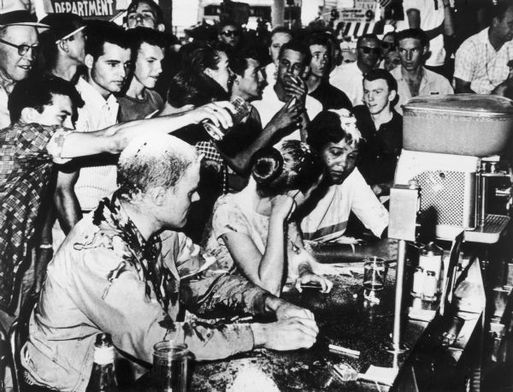Spreading of the Sit-Ins
The preceding morning twenty-nine students, both male and female from
North
Carolina Agricultural and Technical, joined the Greensboro Four and sat
at the Woolworth’s
lunch counter. The protest grew even more on Wednesday, and on
Thursday,
the students from A&T were accompanied by white students who went to
a nearby women’s college. The sit-ins spread to other stores in
Greensboro and flocks of students were mobbing other local lunch
counters. As the protests grew larger, a crowd of white men grew
angrier. These white men began showing up at lunch counters to harass
the
protesters. They would often by spit, use abusive and derogatory
language, and even threw
eggs at the protesting students. During one event, a protester had his
coat set on fire, which resulted in the white man getting arrested.
The protests went on everyday that week. By Saturday, the Greensboro Four had attracted fourteen hundred
students, all of which arrived at the Greensboro Woolworth’s store. The students who could not get a seat at the lunch counter formed protest lines outside the store. One day, a
phoned-in bomb threat ended the protest early. However, by the following week
sit-ins were occurring at Woolworth’s stores in Charlotte, Winston-Salem, and
Durham. Soon other segregated lunch counters at many other department stores became targets of these protests.
For the most part, the police departments kept quiet throughout the sit-ins. The protesters were not harassed by the police department, however they took action when situations turned violent. Throughout the state of North Carolina, no protesters were prosecuted until a large group of forty-one protesting black students in Raleigh were caught trespassing at the Cameron Village Woolworth's.
Regardless of the arrests that were made, progress was increasing. African-Americans were soon allowed to eat with whites at the same lunch counters. By the end of February 1960, both blacks and whites were able to eat together at the S.H. Kress store in Greensboro. In Raleigh, some businesses resulted in closing their lunch counters altogether to end protests. Even though desegregation was not permitted right away in most stores, the sit-ins did prove to be successful. The sit-ins forced partial integration and they increased awareness across the entire nation of how badly African-Americans were treated in the South.
The 1960 Greensboro sit-in proved to be one of the most effective and successful protests of the civil rights movement. Ezell Blair Jr., Franklin McCain, Joseph McNeil and David Richmond all formed this movement without attaining legal action or the help of any association. Their strong perseverance changed segregation as we know it today, all in the matter of one month.
For the most part, the police departments kept quiet throughout the sit-ins. The protesters were not harassed by the police department, however they took action when situations turned violent. Throughout the state of North Carolina, no protesters were prosecuted until a large group of forty-one protesting black students in Raleigh were caught trespassing at the Cameron Village Woolworth's.
Regardless of the arrests that were made, progress was increasing. African-Americans were soon allowed to eat with whites at the same lunch counters. By the end of February 1960, both blacks and whites were able to eat together at the S.H. Kress store in Greensboro. In Raleigh, some businesses resulted in closing their lunch counters altogether to end protests. Even though desegregation was not permitted right away in most stores, the sit-ins did prove to be successful. The sit-ins forced partial integration and they increased awareness across the entire nation of how badly African-Americans were treated in the South.
The 1960 Greensboro sit-in proved to be one of the most effective and successful protests of the civil rights movement. Ezell Blair Jr., Franklin McCain, Joseph McNeil and David Richmond all formed this movement without attaining legal action or the help of any association. Their strong perseverance changed segregation as we know it today, all in the matter of one month.
Timeline of the Greensboro Sit-Ins
February 1, 1960:
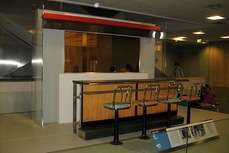
North Carolina A&T State University students, Ezell Blair Jr., Franklin
McCain, Joseph McNeil, and David Richmond go to F.W. Woolworth’s and make small
purchases near the lunch bar. They take seats at the lunch counter where only
whites were allowed to sit. When requested service, they were denied, but
continued to stay seated until the Woolworth store closed early, at 5:30pm.
February 2, 1960:

The four boys return
and sit at the white's only lunch counter at Woolworth's. They were
joined by reporters and local TV news crews. By the next day, protests
had spread to High Point, North Carolina due to the heavy television coverage.
February 3, 1960:
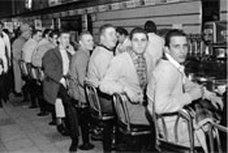
When Woolworth's
opened, students were running to find a seat at the lunch counter.
However, the blacks were accompanied by a growing number of whites who insult
the protesters. The protest is now nationally televised and the protests
spread to Winston-Salem, North Carolina.
February 4, 1960:
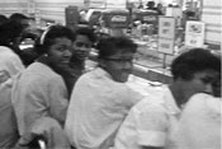
Female students from
Bennett College and three white students from Greensboro Women’s College join
the sit-in. The protests begin to hurt business at Woolworth’s and other
nearby department stores.
February 5, 1960:
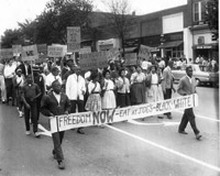
The protests at
Woolworth's has reached over 300 students. The movement spreads across
the country to nearly forty other cities.
February 6, 1960:

Woolworth is filled
with over 1,400 protesters and observers. Kress department store, near
Woolworth's is now a part of the sit-in bringing Greensboro to nearly a
standstill. Woolworth’s and Kress receive phoned-in bomb threats and close
their stores early.
February 7, 1960:

Store officials are
given a chance to comply when A&T students vote to suspend
demonstrations. The businesses fail to comply and students resume the
sit-in.
July 26, 1960:

The lunch counter at
Woolworth’s is integrated.
